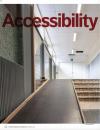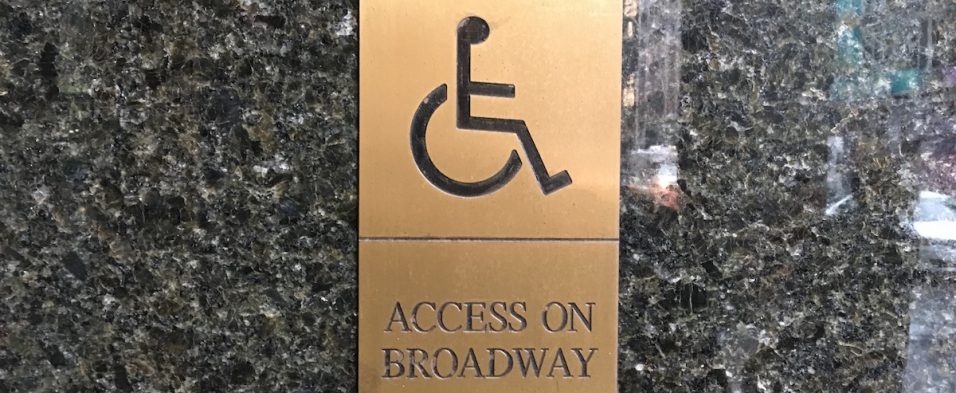An overview of techniques to help with special needs, mobility issues, language barriers or impaired vision or hearing.
At the bottom of the page we have information about theatre companies that work with performers with special needs.
Accessible Events
- Accessible Theatre – Packed with information from Arts Council England
- Five Ways to connect with disabled audiences (from Guardian Culture Professionals blog)
- Hands On – Providing accessibility to arts & cultural events for the Deaf and hard of hearing communities
Amazon Shop
Making Technical Theatre Accessible

Accessibility in Technical Theatre (December 2022)
[External Website]
From Theatre Design & Technology
Using Captions
Many operatic performances are sung in their original language, which may not be the language of the audience. Touring opera companies regularly set up LCD monitors at the edge of the stage so that translations cannot be provided. Permanent opera houses often use surtitles (on screens above the stage). These are known as open captions (OC) as the audience members require no additional equipment to view them.
Some venues provide closed captioning (CC) which often consists of a sheet of semi-transparent mirror which is placed in front of the audience member that would like captions, and reflects a screen at the rear of the auditorium which carries a mirror image (reversed) of the captions.
Captions can be created using a projector and software such as PowerPoint, or a custom-made software tool such as The Difference Engine, which uses a smartphone to deliver the captions. Gala Pro is an app which delivers captions and audio description direct to a users’ mobile device.
The National Theatre in the UK has started to experiment with augmented reality (AR) for the delivery of captions, using Epson Moverio BT-350 Smart Glasses. Those that would like captions get a high quality caption superimposed onto their view of the stage, without disturbing any other audience members. [Article on TechRadar]
StageText provides captioning services to many shows, including Harry Potter and the Cursed Child
Audio Description (AD)
A service greatly appreciated by those with impaired vision, AD involves a describer sitting at the rear of the auditorium (in the booth if there is room) providing a narration describing the action on stage. The skill is in not getting in the way of the on stage dialogue, sound effects or other audible movements on stage, but filling in where vision would help with the plot.
- RNIB page about AD
- Mind’s Eye
- VocalEyes
- GalaPro App – Audio description & captioning direct to audience members’ mobile device
Review of the provision for Audio Description & Touch Tour for Harry Potter and the Cursed Child (2017)
Audio Described Performances at the National Theatre (UK)
Sign Language
Interpretation: A sign language interpreter stands at the side of the stage, near to seating that has been set aside for those with hearing difficulties, and is illuminated by a spotlight. Throughout the performance, the interpreter signs the lines or sound cues that the audience cannot hear.
Theatre companies such as Deaf West Theatre are transforming the relationship that hearing impaired folk have to theatre, including their groundbreaking version of the musical Spring Awakening, with the performers using sign language throughout (see video below).
Assistive Hearing Systems
-
- Induction Loop
Relatively cheap to install, this consists of an amplifier, connected to a loop of impedance-matched cable around the venue, which creates a magnetic field which is easily picked up by anyone with a hearing aid with a ‘T’ switch. It’s the preferred system for any suitable venue, because it requires no extra equipment for the audience member.
However, the quality of the signal can be variable in some venues, depending on the quality of the cable.
- Induction Loop
- Infra-red receiver headphones
A transmitter, mounted at the front of the auditorium, transmits invisible infra-red radiation, which is picked up by a headset worn by any audience member that requires it. The cost is greater than the induction loop, but the quality of the audio is far superior. The headsets require recharging and managing (to ensure the audience members that request it actually receive one, and return it after the event).
- MobileConnect by Sennheiser
-
- New system that uses a users’ smartphone to deliver a high quality audio mix over wifi. See document on the right for details.
More information on Sennheiser’s MobileConnect website
- New system that uses a users’ smartphone to deliver a high quality audio mix over wifi. See document on the right for details.
-
Touch Tour
These are available at some venues / performances, and are designed for audience members who are wheelchair users or have a visual impairment, and are often scheduled before audio described performances. The tours offer a combination of sensory experiences where patrons can experience lighting and sound effects and / or an opportunity to handle props & costumes or explore the scenery. Sometimes the actors will also be present to talk about the characters they play and their costumes.
Relaxed Performances
A Relaxed Performance is one specifically modified to help audience members with special needs to feel at home in the theatre, and to enable them to feel able to make noise and comment on the performance when they wish to. They are designed for audience members with autism, learning disabilities and sensory or communication needs. The sound level is often reduced, complex lighting changes are simplified, and the cast and company warn families when unexpected noises will occur. Often the house lights are left on, and the audience is given a pre-show tour of the theatre so that they are familiar with the environment. The performances sit alongside special measures for audio-description and signed performances for those with sight or hearing impairments, and were introduced to the West End in mid 2013.
- “‘Relaxed’ theatre performances will let autistic children enjoy hit shows” (The Guardian, 16 June 2013)
- Prince Edward Theatre receives award from National Autistic Society (The Stage, May 2018)
Related Articles
- Asda introduces quiet hour (Manchester Evening News, 23 April 2016)
- Society of London Theatres – Accessibility
- Visit London Accessibility
- DisabledGo
Theatre Companies
Inclusive theatre companies that work with performers and technicians with special needs, including mobility needs.
Disability Arts Online is a great resource site listing a huge number of companies and information.
- Chickenshed (North London, UK) https://www.chickenshed.org.uk
- FaceFront (London, UK) http://facefront.org
- Graeae (London, UK) https://graeae.org
- TramShed (Blackpool, UK) https://tramshed.org.uk
- TwoCan Theatre (Gloucestershire, UK) http://www.twocantheatre.org.uk
Keywords: disabled access, accessible venues, accessible theatre, accessible performances, hearing impairment, hearing impaired, autism, intellectual disability




